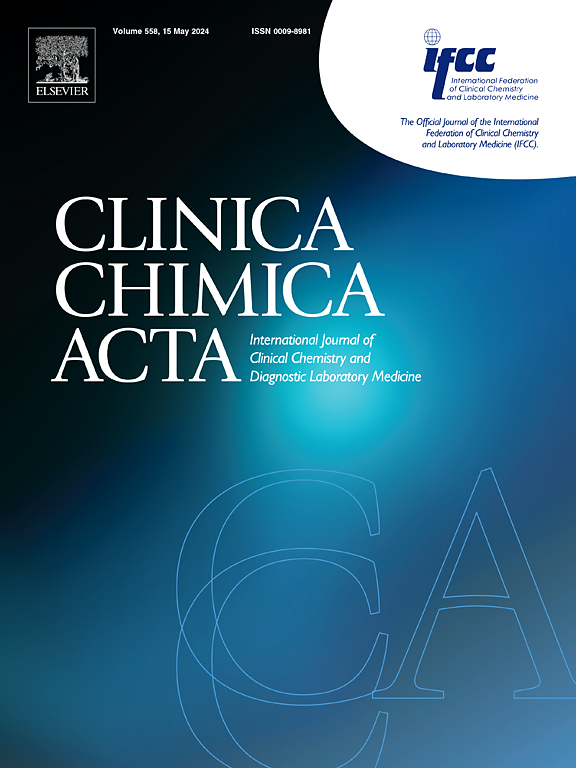综合代谢组学和脂质组学揭示非小细胞肺癌伴脑转移的血浆标志物。
IF 2.9
3区 医学
Q2 MEDICAL LABORATORY TECHNOLOGY
引用次数: 0
摘要
脑转移是非小细胞肺癌(NSCLC)的致命并发症。缺乏无创早期诊断和风险分层的方法是NSCLC合并BM预后不良的主要原因。BM的代谢状态发生显著变化,表现为高活性氧积累和随后的抗氧化代谢反应。我们试图筛选基于代谢组学和脂质组学的血浆标志物,用于NSCLC合并BM患者的早期诊断和预后评估。将48例合并BM的非小细胞肺癌患者和49例性别和年龄匹配的原发性肺癌(PLC)患者的血浆样本随机分为训练组和测试组,采用液相色谱-串联质谱(LC-MS)进行代谢组学和脂质组学分析。从列车组中发现了差异代谢物和脂质。采用logistic回归构建诊断性生物标志物面板。利用测试集验证诊断模型的准确性。此外,建立了一个风险评分来对NSCLC患者的风险进行分层。在训练集中注释了34种差异代谢物和35种差异脂质。由同型半胱氨酸、抗坏血酸、LPC(22:0)和LPC(20:0)组成的诊断生物标志物组能够以优异的性能区分BM和PLC。基于原儿茶酸和LPC的风险评分(20:0)可以有效地对NSCLC合并BM患者进行风险分层。我们的研究报告了血浆生物标志物和预测模型用于NSCLC合并BM患者的早期诊断和预后评估。本文章由计算机程序翻译,如有差异,请以英文原文为准。
Integrated metabolomics and lipidomics reveal plasma markers of non-small cell lung cancer with brain metastasis
Brain metastasis (BM) is a fatal complication of non-small cell lung cancer (NSCLC). The lack of non-invasion methods for early diagnosis and risk stratification is the major cause for the poor prognosis of NSCLC with BM. The metabolic state of BM has a significant change characterized with high reactive oxygen species accumulation and the subsequent antioxidant metabolic response. We sought to screen plasma markers based on metabolomics and lipidomics for the early diagnosis and prognostic evaluation of NSCLC patients with BM. Plasma samples collected from 48 NSCLC patients with BM and 49 gender- and age- matched primary lung cancer (PLC) patients were randomly divided into train set and test set, then analyzations of metabolomics and lipidomics were performed using liquid chromatography-tandem mass spectrometry (LC-MS). Differential metabolites and lipids were discovered from the train set. A diagnostic biomarker panel was constructed using logistic regression. The test set were utilized to validate the accuracy of the diagnostic model. Furthermore, a risk score was established to stratify risk for NSCLC patients. There were 34 differential metabolites and 35 differential lipids annotated in the train set. The diagnostic biomarker panel consisting of homocysteine, ascorbic acid, LPC (22:0) and LPC (20:0) is able to discriminate BM from PLC with an excellent performance. The risk score based on protocatechuic acid and LPC (20:0) could efficiently stratify risk for NSCLC patients with BM. Our study reports plasma biomarkers and predictive models for the early diagnosis and prognostic evaluation of NSCLC patients with BM.
求助全文
通过发布文献求助,成功后即可免费获取论文全文。
去求助
来源期刊

Clinica Chimica Acta
医学-医学实验技术
CiteScore
10.10
自引率
2.00%
发文量
1268
审稿时长
23 days
期刊介绍:
The Official Journal of the International Federation of Clinical Chemistry and Laboratory Medicine (IFCC)
Clinica Chimica Acta is a high-quality journal which publishes original Research Communications in the field of clinical chemistry and laboratory medicine, defined as the diagnostic application of chemistry, biochemistry, immunochemistry, biochemical aspects of hematology, toxicology, and molecular biology to the study of human disease in body fluids and cells.
The objective of the journal is to publish novel information leading to a better understanding of biological mechanisms of human diseases, their prevention, diagnosis, and patient management. Reports of an applied clinical character are also welcome. Papers concerned with normal metabolic processes or with constituents of normal cells or body fluids, such as reports of experimental or clinical studies in animals, are only considered when they are clearly and directly relevant to human disease. Evaluation of commercial products have a low priority for publication, unless they are novel or represent a technological breakthrough. Studies dealing with effects of drugs and natural products and studies dealing with the redox status in various diseases are not within the journal''s scope. Development and evaluation of novel analytical methodologies where applicable to diagnostic clinical chemistry and laboratory medicine, including point-of-care testing, and topics on laboratory management and informatics will also be considered. Studies focused on emerging diagnostic technologies and (big) data analysis procedures including digitalization, mobile Health, and artificial Intelligence applied to Laboratory Medicine are also of interest.
 求助内容:
求助内容: 应助结果提醒方式:
应助结果提醒方式:


